Anchorage In Orthodontics
Question 1. Define anchorage in orthodontics. Explain its types giving suitable examples.
Or
What is anchorage? Describe different types of anchorage in orthodontics.
Or
Write short note on anchorage.
Or
Define anchorage. Give its classification. Briefly describe the types of anchorage.
Or
What is anchorage. Discuss various types of anchorage in orthodontics.
Or
Define anchorage. Write classification of anchorage and detail about it.
Or
Write short note on anchorage consideration in orthodontics.
Or
Describe anchorage and its classification. Describe the various types of anchorage.
Or
Define anchorage. Write in detail about classification and types of anchorage.
Or
Define anchorage. How is it classified? Write briefly about intermaxillary anchorage.
Answer. “Anchorage in orthodontics is the nature and degree of resistance to displacement offered by an anatomic unit for the purpose of effecting tooth movement.”
Types/Classification of Anchorage by (Moyers)
According to the Manner of Force Application
- Simple anchorage.
- Stationary anchorage.
- Reciprocal anchorage.
According to Jaw Involved
- Intermaxillary.
- Intramaxillary.
Read And Learn More: Orthodontics Question And Answers
According to the Site of Anchorage
- Intraoral
- Intramaxillary
- Simple
- Stationary
- Reciprocal.
- Intermaxillary
- Intramaxillary
-
-
- Simple
- Stationary
- Reciprocal.
- Extraoral
-
-
-
- Cervical
- Occipital
- Cranial
- Facial.
- Muscular.
-
According to the Number of Anchorage Unit
- Single or primary anchorage.
- Compound anchorage.
- Multiple or reinforced anchorage.
Nanda’s Classification of Anchorage
Depending on that how much is the anchorage unit contribute to extraction space closure. Nanda classified anchorage into three groups i.e. A, B, C.
Group 1 Space Closure
- 100 to 75% space closure from anterior retraction and 25% closure from posterior anchorage movement.
- There is critical posterior anchorage.
Group 2 Space Closure
- It includes more equal amount of anterior and posterior tooth movement for space closure
- This is the easy condition to deal with.
Group 3 Space Closure
- It includes 75 to 100% of posterior protraction. There is a non-critical anterior anchorage and critical posterior anchorage.
- Anterior retraction is only 25%.
- It is a non-critical anchorage.
According to Number of Anchorage Unit
Single or Primary Anchorage
- In this, resistance is provided by a single tooth with greater alveolar support which is used to move the tooth with less alveolar support.
- Example is moving a tooth with smaller root surface area against a tooth with large root surface area and is known as an anchor.
Compound Anchorage
Here, the resistance is provided by more than one tooth with greater support and is used to move teeth with the lesser support.
Types of Anchorages
Anchorage in orthodontics is always in the combination of many types of anchorages which are used when teeth are to be moved.
According to Manner of Force Application
Simple Anchorage
- It is defied as “dental anchorage in which the manner and application of force is such that it tends to change the axial inclination of the tooth or teeth that form the anchorage unit in the plane of space in which the force is being applied.”
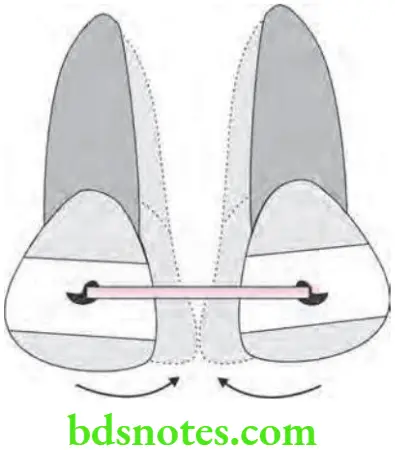
- It is the resistance offered by anchorage unit to tipping.
- Its resistance value is low.
- This resistant to tipping is use to move another tooth.
Stationary Anchorage
- It is defied as “dental anchorage in which the manner and application of force tends to displace the anchorage unit bodily in plane of space in which the force is being applied”.
- Stationary anchorage is the resistance to bodily movement.
- Example of stationary anchorage is: Molars are used as anchoring teeth for retraction of maxillary incisors.
- In real sense, only extra-oral source of anchorage derived from head gears is the best example of stationary anchorage.
Reciprocal Anchorage
- It refers to the resistance offered by the two malposed unit.
- When dissipation of equal and opposite forces tends to move each unit towards each other in a normal occlusion.
- Two teeth or two groups of teeth of equal anchorage value are made to move in opposite direction.
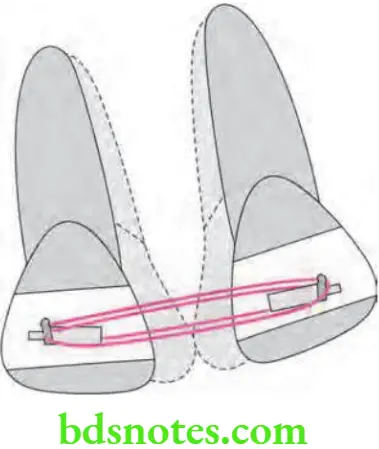
- Example of reciprocal anchorage is:
-
- Closure of midline diastema—By moving two central incisors towards each other.
- Crossbite elastics—For correction of single tooth posterior crossbite.
According to Jaw involved
Intramaxillary Anchorage
- In intramaxillary anchorage all the anchoraging lie in the single jaw.
- For this appliances are either placed in maxilla or in mandible.
- It is divided into three types, i.e. simple, stationary and reciprocal type.
- Example: Elastic chains use to retract anterior segment using posterior teeth as anchorage units.
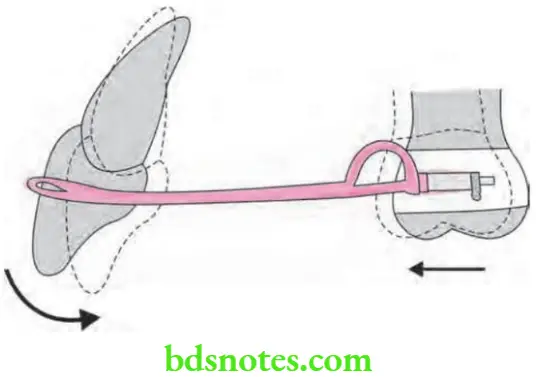
Intermaxillary Anchorage
- Anchorage in which the resistance unit situated in one jaw are used to effct tooth movement in the opposing jaw is known as intermaxillary anchorage.
- Baker’s anchorage is an example for intermaxillary anchorage.
- Baker’s anchorage is the type of intermaxillary anchorage for adjusting both jaw relation and teeth with the help of applying elastic from maxilla to mandible.
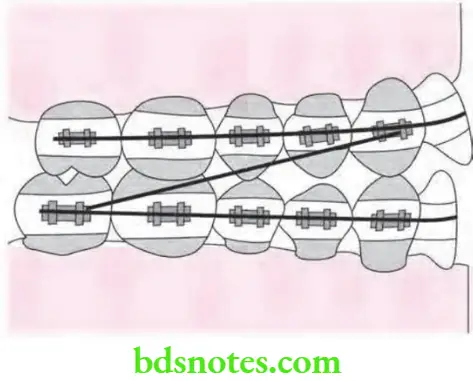
Class 2 malocclusion correction: Elastics are applied between the lower molar and upper anterior.
Class 3 malocclusion correction: Elastics are applied between the upper molar and lower anterior.
According to Site of Anchorage
Intraoral Anchorage
- Anchorage in which all the resistance units are situated within the oral cavity is known as intraoral anchorage.
- Sources for intraoral anchorage are teeth, palate and lingual alveolar bone of mandible.
- It is classified into two divisions, i.e. intramaxillary anchorage and intermaxillary anchorage.
Extraoral Anchorage
- Anchorage in which the resistance units are situated outside the oral cavity is termed extraoral anchorage.
- Various extraoral anchorage sites along with their examples are:
- In occiput region: Head pullgear and chin cup can be given.
- Back of the neck: Cervical headgear is used.
- Forehead: Reverse pull headgear is used.
- Chin: Reverse pull headgear and chin cup can be given.
- Extraoral anchorage is used in correction of skeletal problems.
- Can be used as a form of reinforced anchorage.

Muscular Anchorage
- In some cases perioral musculature is employed as resistance unit.
- Muscular anchorage makes use of forces generated by muscle to aid in movement of teeth. Example of muscular anchorage is usage of lip bumper to distalize molars.
Reinforced Anchorage
- It is also known as multiple anchorage.
- In this more than one type of resistance unit is utilized.
- The resistance units become more and more effective when numerous units are added since the reactionary force should be distributed over a wide range of area.
- As the forces are distributed, their effect become light which leads to less trauma and pain at time of orthodontic treatment.
- Examples are:
- Transpalatal arch and lingual arch reinforces the anchoring unit.
- Headgears augment the resistance units.
Other Types of Anchorages
Cortical Anchorage
- Cortical bone provides more resistance to resorption as compared to medullary bone.
- Response of the cortical bone when compared to medullary bone is very different. If the roots are torque lingually or buccally, resistance to movement get increased this is known as cortical anchorage.
- Example is space closure at old extraction site is difficult as roots encounter cortical bone along the residual ridge.
Implants as Anchorage
- In modern era, orthodontic implants are used as anchorage units.
- Various orthodontic implant are orthosystem implant, Aarhus implant, on plant, mini implants.
- Orthoimplant system is a screw type endosteal implant of 4 to 6 mm in length. Aarhus implant is small in size and its early loading is possible, so it is used in multiple sites in between the roots. Onplant is a disc shaped structure which is placed in the hard palate over posterior aspect under local anesthesia. Mini implants are very small.
Question 2. Write short note on reciprocal anchorage.
Or
Write briefly on reciprocal anchorage.
Answer.
Reciprocal Anchorage
- It refers to the resistance offered by the two malposed unit.
- When dissipation of equal and opposite forces tends to move each unit towards each other in a normal occlusion.
- Two teeth or two groups of teeth of equal anchorage value are made to move in opposite direction.
- Example of reciprocal anchorage are:
- Closure of midline diastema—By moving two central incisors towards each other.
- Crossbite elastics—For correction of single tooth posterior cross bite.
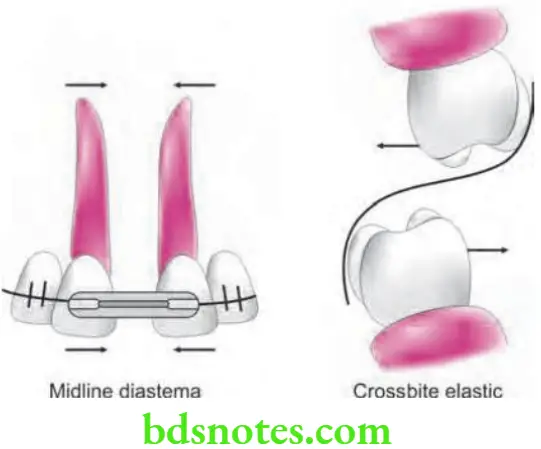
Question 3. Write short note on anchorage with reinforced anchorage.
Or
Write short note on reinforced anchorage.
Answer. It is also known as multiple anchorage.
- In this more than one type of resistance unit is utilized.
- Reinforced anchorage is the augmentation of anchorage by various methods i.e. extraoral appliances, upper anterior inclined plane or transpalatal arch.
- Here the extra forces are generated from extraoral sites cranium, back of the neck and face
- The resistance units become more and more effctive when numerous units are added since the reactionary force should be distributed over a wide range of area.
- As the forces are distributed, their effct become light which leads to less trauma and pain at time of orthodontic treatment.
- Reinforced anchorage is done by various methods such as:
Extraoral Forces to Augment Anchorage
Forces which are generated from the extraoral areas i.e. cranium, back of the neck and face is used to reinforce the anchorage.
Upper Anterior Inclined Plane
A removable appliance which incorporates an upper anterior inclined plane leads to the forward glide of the mandible at the time of closure of the jaw. This causes stretching of retractor of muscle of mandible which contract and forces the mandible against upper inclined plane. So a distal force is applied over maxillary teeth reinforcing the maxillary anchorage. Modification of the anterior inclined plane is Sved appliance which has an additional upper incisal capping.
Use of Transpalatal Arch and Lingual Arches
Transpalatal is a wire which spans palate in the transverse direction connecting first molars of either side. These are indicated in fied mechanotherapy to augment the anchorage. Similarly an arch connecting the contralateral mandibular molars run along the lingual aspect of mandibular arch and prevents the mesial movement of mandibular molars. This is known as lingual arch. Both the lingual and transpalatal arch get soldered to lingual aspect of molar bands which are cemented to these teeth.

Question 4. Define anchorage and its importance. Discuss various types of anchorage used in orthodontics.
Answer.
Importance of anchorage— Whenever a force is applied, it produces an equal and opposite reactive force.
- For tooth movement to occur in the desired direction this reactive force should be equal to or greater than the force applied.
- The areas or units which provide the resistance to the reactive force thereby preventing undesirable tooth movement are called anchorage units.
- Thus, anchorage prevents undesirable tooth movement and provide adequate force to desirable tooth movement.
Question 5. Differentiate intermaxillary and intramaxillary anchorage.
Answer.
Intramaxillary Anchorage
- When all the units offering resistance are situated within the same jaw the anchorage is described as intramaxillary.
- In this type of anchorage the teeth to be moved and the anchorage units are all situated entirely in maxilla or in mandible.
- For example—Class I elastics, labial bow, coffin springs.
Intermaxillary Anchorage
Anchorage in which the resistance unit situated in one jaw are used to move the teeth of opposite jaw, e.g.
- Baker’s anchorage.
- Class 2 elastic traction.
- Class 3 elastic traction.
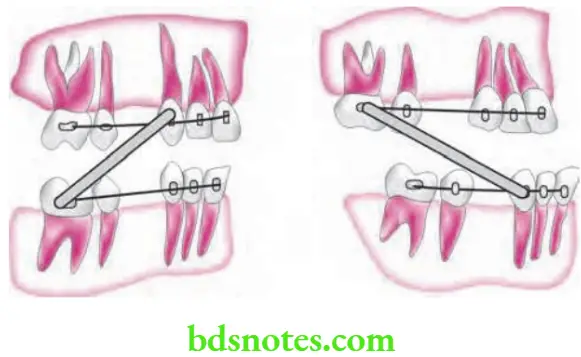
Question 6. Write short note on simple anchorage.
Answer. Simple anchorage is defied as, “dental anchorage in which the manner and application of force is such that it tends to change the axial inclination of the tooth or teeth that form the anchorage unit in the plane of space in which the force is being applied.”
- It is the resistance offered by anchorage unit to tipping.
- Its resistance value is low.
- This resistance to tipping is used to move another tooth.
- Simple anchorage is obtained by engaging with appliance a greater number of teeth than are to be moved within a same dental arch.
- Combined root surface area of teeth forming the anchorage unit must be double that of the teeth to be moved. So, the resistance offered by anchorage unit is greater than offered by tooth or teeth being moved.
Question 7. Write short note on extraoral anchorage.
Or
Define and classify anchorage. Describe extraoral anchorage.
Or
Define anchorage. Classify and explain. Write in detail on extraoral anchorage.
Answer.
Extraoral Anchorage
- Anchorage in which the resistance units are situated outside the oral cavity is termed extraoral anchorage.
- Extraoral anchorage is used in correction of skeletal problems.
- Can be used as a form of reinforced anchorage.
- Various extraoral anchorage sites along with their examples are:
- In occiput region: Head pullgear and chin cup is adviced.
- Back of the neck: Cervical headgear is advised.
- Forehead: Reverse pull headgear is advised.
- Chin: Reverse pull headgear and chin cup is advised.
- In parietal region: Combination headgear is advised.
Advantages
- Anchorage established from extraoral anchorage source is much greater than intraoral anchorage source, since extraoral anchorage units are more stable.
- There is lesser risk of anchor loss.
Disadvantages
When extraoral anchorage is employed, the success of treatment lies entirely on patient compliance. Patient has to wear the extraoral appliance (headgear) for a minimum of l2–15 hours a day to achieve the desired effct.
Question 8. Briefly differentiate between stationary and reciprocal anchorage. Answer.
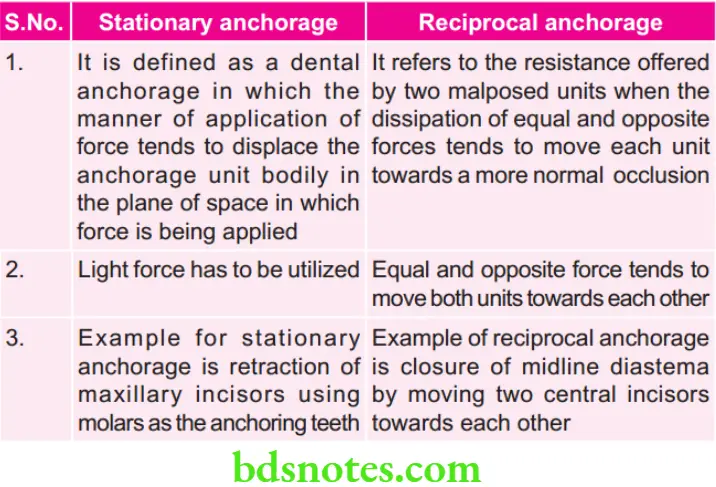
Question 9. Write short note on load deflection rate.
Or
Write short answer on load deflection rate.
Answer. It is the characteristic of an orthodontic appliance.
- The load deflection (or torque-twist) rate, is a factor to the delivery of a relatively constant force.
- Load deflection rate is defied as the amount of force generated per unit of activation.
- If a spring is activated 3 mm and it generates 150 g of force the load deflction rate of the spring would be 150 g/3 mm = 50 g per mm of activation.
- Load deflction rate = Load/deflection
- It is desirable for an appliance to have a low deflection rate since such an appliance would produce a lower more constant force that is active over a long duration.
- As the load deflection rate declines for a tooth that is moving under a continuous force, the change in force value is reduced.
- For active members a low load-deflection rate is desirable for two important reasons:
-
- A mechanism with a low load deflction rate maintains a more desirable stress level in the PDL because the force on a tooth does not radically change magnitude every time the tooth has been displaced.
- A member with a low load deflction rate offrs greater accuracy in controlling force magnitude.
- Flexible members with low load deflection rates require long ranges of activation to build up to optimal force values; hence they give the orthodontist greater control over the magnitude of force used.
- If a low load deflection rate is desirable for the active member of the appliance, the opposite is true for the reactive member.
Question 10. Write short note on Baker’s anchorage.
Answer. Baker’s anchorage is the type of intermaxillary anchorage for adjusting both jaw relation and teeth with the help of applying elastic from maxilla to mandible.
- Class 2 malocclusion correction: Elastics are applied between the lower molar and upper anterior.
- Class 3 malocclusion correction: Elastics are applied between the upper molar and lower anterior.
Question 11. Differentiate between primary vs secondary anchorage.
Answer.
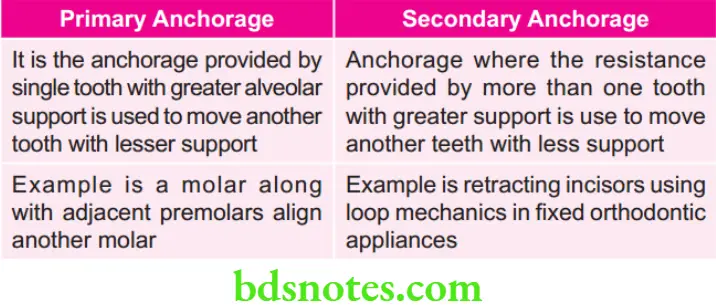
Question 12. Distinguish between intraoral anchorage vs extraoral anchorage.
Answer.
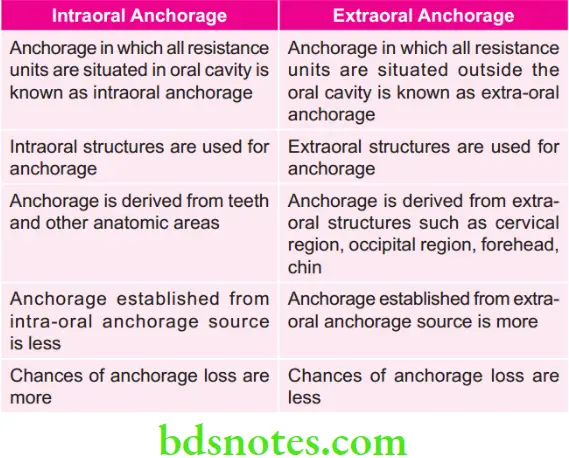
Question .13. Differentiate tipping vs torque movement.
Answer.
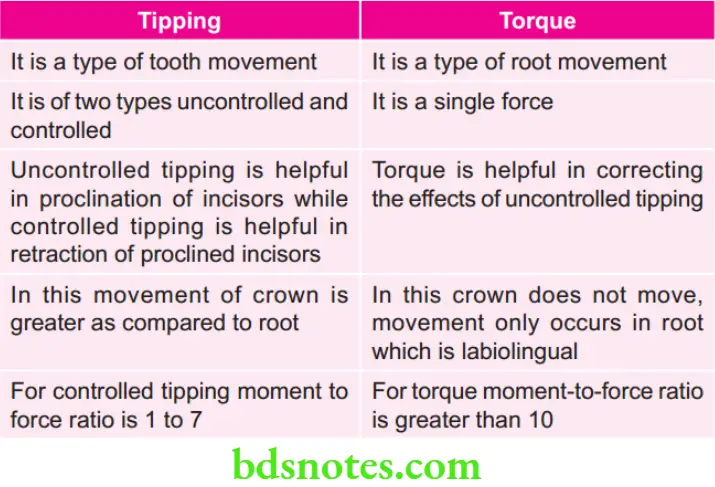
Question 14. Write short answer on temporary anchorage device.
Answer. Temporary anchorage device is defined as a device that is temporarily fied to bone for the purpose of enhancing orthodontic anchorage either by supporting the teeth of reactive unit or by obviating the need for the reactive unit altogether, and which is subsequently removed aftr use.
Cope
Temporary anchorage device is also known as ortho implant or mini implant or microimplant or miniscrews or skeletal anchorage devices or microscrews.
Temporary anchorage device produce absolute anchorage and minimizes the side effct of unwanted opposing force at the time of orthodontic movement.
Indications
Miniscrews are used for the three groups of tooth movements to reinforce anchorage i.e.
- Mesial or distal movement of buccal teeth
- Lingual or the labial movement of anterior teeth
- Vertical intrusive movement of buccal or anterior teeth
Following are the indications of temporary anchorage device:
- Patients who lost their posterior teeth
- As an anchorage for distalization of molars
- For intrusion of maxillary teeth
- For anterior open bite and deep bite correction
- As source of anchorage for retraction of canines as well as anteriors
- For correcting the canted occlusal planes
- As an aid in treatment of Class III malocclusion.
Types of Microimplants
According to the exposure of the head
- Open method: Head of the microimplant is exposed to oral cavity. Open method is used when implant is placed in an area where the sof tissues are not movable i.e. attached gingiva.
- Closed method: Head of the microimplant should be embedded under the sof tissue. Closed method is used when implant is placed in an area where the soft tissue is movable.
According to the method of placing the implant
- Self tapping method: Here a tunnel is fist drilled inside the bone and then the implant is tapped in. This method is mainly used for smaller diameter microimplants.
- Self drilling method: In this method an implant drills itself into the bone. It is used for larger diameter microimplants.
According to the path of microimplant insertion
- Oblique direction: In this the insertion of microimplant is diagonally at an angle of 30 to 60 degree to the long axis of tooth. This method is used in areas where interradicular bone is very narrow.
- Perpendicular: In this the microimplant is inserted perpendicular to the bony surface. This method is used if there is sufficient interradicular bone.
Procedure of Placement of Temporary Anchorage Device
- Procedure is carried out by the orthodontist as an adjunct to the orthodontic treatment.
- An intraoral periapical or a panoramic radiograph of the particular region is needed to evaluate interradicular space present. Ideally minimum of 2 mm interradicular bone is needed.
- Give minimal amount of local anesthetic to the mucosa which lies adjacent to the proposed implant placement site. Since underlying bone does not consists of innervation and profound anesthesia of the adjacent teeth and periodontal ligaments is contraindicated.
- If the drill or implant approaches towards periodontal ligament it would lead to some pain to the patient which will alert the orthodontist to redirect the implant. This pain feedback from the patient would not be possible with profound anesthesia.
- Drill a pilot hole with a 1.2 mm twist drill at 600 rpm to just short of the implant length. Provide adequate cooling with a physiological saline solution while drilling, to avoid thermal damage to the bone.
- Insert the implant by using a hand piece at 12 rpm or can be hand driven with a hand driver.
- Take a post operative radiograph to assess the proper placement of implant.
- Following insertion, the peri-implant tissues are gently rinsed with sterile saline solution before the screws are loaded.
Removal of the Implant
- As treatment get complete the temporary anchorage device can be easily removed.
- Removal of the mini – implants is easily done with the same screw driver as used for insertion.
- Whole of this procedure is carried out under application of a local anesthetic gel.
- Removal site should be gently swabbed with a 0.2% chlorhexidine.
- Wound present at time of screw removal is minimal and usually closes within a few days. In most of the cases, healing will continue uneventfully.
Possible Complications of Temporary Anchorage Device
Since placement of temporary anchorage device is a surgical procedure, so some of its potential complication are as follows:
- Contact with adjacent roots: It is possible while placing the temporary anchorage devices. It has been seen that minor root contact does not lead to any serious long term damage. If patient expresses discomfort at the time of placing, it is possibly because of close approximation of the periodontal ligament. During placement, if increased resistance is felt during drilling or placing the implant it could be due to root contact. This can be verifid by a radiograph. It may be required to reposition the implant.
- Breakage of implant: It is extremely rare for bone to give enough resistance which break an implant; if resistance is present, orthodontist should ensure that the implant is not being directed into a root. If an implant breaks an attmpt should be made to remove it unless it is too deep.
- Damage to anatomic structures: When implants are placed in maxillary premolars and molars the maxillary sinus can be approximated. This can be avoided by placing the implants coronally in attched gingiva.
- Soft tissue overgrowth: If there is sof tissue overgrowth over the head of implant, this can produce diffilty in placing attachments to them and can also irritate the tissues. This is avoided by ensuring the implant enters via attached gingiva and not the unattached alveolar mucosa.
- Loosening of implant: It is the most common complication and may occur any time following implant placement. Some of the causes of implant loosening are poor bone quality, excessive force application and approximation to the root surface. If an implant get loose, an initial solution may involve simply tightening the implant a few more turns. If it loosens again, remove the implant and replace it in a new position. If space is enough, a larger diameter implant can be placed inside the same hole.
Question 15. Describe briefly various extraoral appliances in orthodontics as anchorage.
Answer.
various Extraoral Appliances in Orthodontics as Anchorage
Extraoral appliances used in orthodontics as anchorage are:
- Head gear
- Face mask
- Chin cup
Leave a Reply